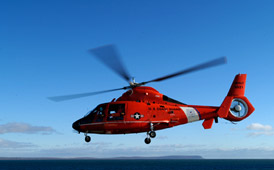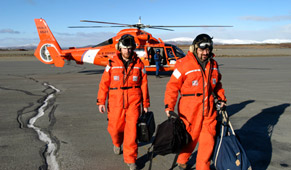 |
Daily Update
Calendar
Dispatch 39 - October 18, 2003
By C. A. Linder
Weather conditions: Clear skies, 25 kt winds, 1-2 ft seas,
air temperature 32°F
Home at Last
Stars weren't the only lights I saw when I ventured outside on the
morning of the 18th of October... On the horizon was a string of
lights - city lights! Thanks to following winds and seas, we made
it to Nome in record time. Only a few miles away was LAND. The low
mountains of Alaska's Seward Peninsula were bathed in snow and alpenglow.
We hadn't seen land or civilization since September 11th. It was
strange to think that in a matter of hours we would be like tiny
fish swimming in a sea of humanity in busy airports.
 |
 |
| Land! The snow-capped mountains of Alaska's Seward Peninsula. |
One of the ship's helicopters ferried our science party in groups
of three to the Nome airstrip, where we first put our feet on dry
land. Even though we didn't experience that much motion on the ship,
there was always some very slight movement -- a movement which stays
in your brain in the form of "land sickness." For some
people it can take a few days for the world to stop shifting unexpectedly!
Our first stop was the Alaska Airlines terminal, where some of us
arranged flights for that evening, and others made plans to fly
out the next day.
After checking in, we explored the small town of Nome. Nome reminded
me of an old wild west movie set. Clapboard shops line the wide,
dusty streets and the pace of life is relaxed. Instead of horses,
though, pickup trucks were parked outside of the saloons. At the
end of the 19th century, Nome was a thriving gold-rush town of over
20,000 people. It's now known primarily as the end of the Iditarod,
the famous sled dog race that starts in Anchorage, over 1,150 miles
away! It was strange wandering the streets and catching an occasional
glimpse of the Healy bobbing on the waves only a few miles
away.
We then returned to the airport and began the first leg of what
(for us New Englanders) was to be a very very long and tiring journey.
First stop, Anchorage. Next stop, Seattle. Next stop, Boston. Next
stop, Cape Cod. Some of our group were lucky - they were home when
the plane stopped in Fairbanks, Alaska, or Seattle, Washington.
Others were less lucky, like Dan Schuller, who was flying all the
way to Trinidad for another cruise!
 |
 |
 |
| The first flight to Nome takes off. |
Jeremy Kasper (left) and Dan Torres (right) set their feet on dry land for the first time in 5 1/2 weeks. |
| Click
to enlarge |
Click to enlarge |
Some very special people made this project a real delight for me
this year. Thanks especially to Mrs. Cadwell's, Mrs. Rollo's,
and Mr. Jarvi's classes at Varnum Brook Elementary School,
Mrs. Werner's and Mrs. Rodgers' classes at the Morse Pond
School, and Mrs. Lyons' class at Mt. Alvernia Academy.
Everyone in the science party enjoyed answering your questions.
You helped us see the Arctic from a new perspective.
Thanks to our sponsors at the Office
of Naval Research and National Science Foundation for providing
funding for this field project. Thanks to Bob Pickart for once again
inviting me to come along as a “field correspondent.” Thanks to
WHOI Media Relations for the generous use of photo equipment. Thanks
to Dina Pandya and Danielle Fino
for their outstanding work on the website design.Thanks to my family
and friends who sent me so many encouraging emails. Thanks to Gratia
Montgomery for her love and support of oceanography. Thanks to Captain
Oliver and the crew of the Healy for their tireless efforts
to support our science and keep us safe. Thanks to Dennis Conlon,
program manager at the Office of Naval Research, who funded the
moorings.
I'll close this chapter with a final question from Mrs.
Lyons' 5th grade class at Mt. Alvernia Academy, Chestnut Hill, Massachusetts.
Question from Matt and Olivia: Do you like it up
there? Do you plan to go back again?
Answer: Hi Matt and Olivia, thanks for the question.
The Arctic Ocean is an amazing place that very few people on this
earth have ever experienced. There is no way to convey how incredible
it is to see polar bears and walruses in their natural habitat,
fogbows arcing over the ship, or a vast field of ice at sunset.
Last year my best descriptive word for the Arctic was "surreal,"
since it was unlike anything I have ever seen. Although I am exhausted
from this trip and missed my family and friends, I am planning to
return next year. I hope you can join us "virtually" as
well!
Before I forget - for anyone who is still wondering what that worm
was that we found on one of the moorings... Carin Ashjian tells
me that the CT scan revealed that the critter had no bones at all.
So far she thinks that the worm is a marine leech. They are parisitic,
surviving by feeding off of fish. If I find out anything else, I'll
add it to this dispatch.
In the next few weeks, be sure to revisit the image gallery - I
will be selecting my "best of the best" photos and writing
small essays about why each one has meaning for me. I plan to finish
by the end of November.
And next year? In September 2004 we anticipate meeting the Healy
in Dutch Harbor, where we began our journey in 2002. Join us as
we pick up the moorings for the last time. Hopefully they will bring
us another year's worth of data from the Arctic shelf edge. See you then!
 Previous
Dispatch Previous
Dispatch
Back to
Calendar
|




